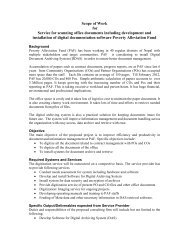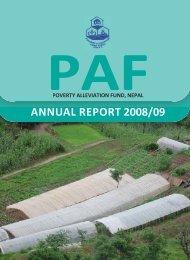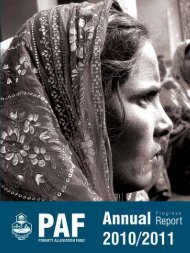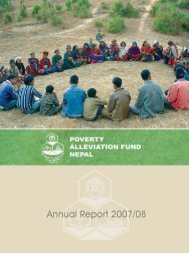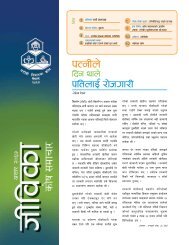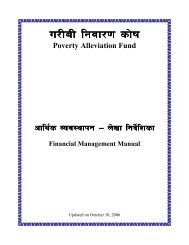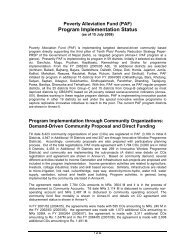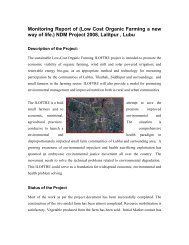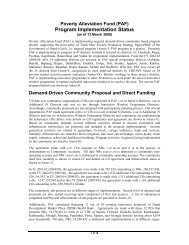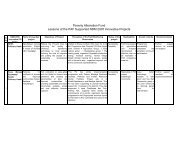Fiscal year 2010/11 - Poverty Alleviation Fund, Nepal
Fiscal year 2010/11 - Poverty Alleviation Fund, Nepal
Fiscal year 2010/11 - Poverty Alleviation Fund, Nepal
You also want an ePaper? Increase the reach of your titles
YUMPU automatically turns print PDFs into web optimized ePapers that Google loves.
shown in the graph below), it is obvious that PAF is focusing on<br />
socially excluded and disadvantageds groups such as Dalit and<br />
Janajati. By and large, PAF has covered almost 100 per cent of<br />
Dalit in initital 25 districts. Also PAF has benefited almost 90 per<br />
cent of the poor households in 25 districts.<br />
Programme Cost Sharing<br />
1200000<br />
1000000<br />
800000<br />
600000<br />
400000<br />
200000<br />
Percentage<br />
80.00<br />
70.00<br />
60.00<br />
50.00<br />
40.00<br />
30.00<br />
20.00<br />
10.00<br />
0.00<br />
0<br />
Dalit, <strong>11</strong>.66<br />
Total HH<br />
Janajati,<br />
18.66<br />
District<br />
Total District Poor<br />
HH<br />
Chart a: PAF Benefited Poor HHs in 25 Districts<br />
Others,<br />
69.69<br />
Dalit,<br />
29.43<br />
PAF Benefitted HH<br />
(93.42% of District Poor HH)<br />
Janajati,<br />
25.92<br />
CO Member<br />
Beneficiaries<br />
Others,<br />
44.66<br />
Chart b: District Population Ethnicity Composition Vs PAF Beneficiary in<br />
25 Districts<br />
PAF is investing 80.6 per cent (i.e. Rs. 9,183m) of the total subproject<br />
cost. Community sharing is 15 per cent (7 per cent in<br />
Cash— i.e. Rs. 761m and 8 per cent in Kind—i.e. Rs. 881m) of the<br />
total sub-project costs whereas VDC/DDC and other development<br />
partners are sharing 5 per cent (i.e. Rs. 564m) in total sub-project<br />
cost. In Income Generating sub projects, community is sharing 9<br />
per cent in cash and 2 per cent in kind whereas in Infrastructure<br />
sub projects, it is 1 per cent in cash and 24 per cent in kind. Apart<br />
from community contribution, DDC/VDC are sharing 1 per cent of<br />
the cost and other collaborating partners are sharing 4 per cent of<br />
the cost in infrastructure sub-projects.<br />
Out of the total PAF investment, 79 per cent is for income<br />
generating sub-projects and 21 per cent for infrastructure subprojects.<br />
About 87 per cent of the PAF investment in income<br />
generating sub-projects is established in community managed<br />
Revolving <strong>Fund</strong>(RF).<br />
Community Institutional Development<br />
Community institutionalization process is taking place in some<br />
of the districts where community has felt need to federate<br />
themselves for certain purpose. Multi-purpose co-operatives,<br />
co-operatives for single purpose and federation of COs are<br />
formed as per communities’ felt need. Informal networks of COs<br />
are being formed in each VDC as a process of instiutionalization.<br />
A total of 166 CO federations are formed till the end of the<br />
reporting <strong>year</strong>. Also, 53 cooperatives are established on the<br />
aegis of the PAF supported community organizations to carry<br />
out different activities aiming at alleviating poverty.<br />
Collaboration in Sub-projects Implementation<br />
PAF emphasized in collaboration with different partners while<br />
implementing its program its program at the district level. For<br />
this purpose, PAF has signed MoUs with MLD, WFP, DNPWC,<br />
REDP, Helvetas, USAID/EIG, Heifer, LFLP and FNCCI, among<br />
others so to strengthen synergies between programmes.<br />
PAF Outcomes<br />
The follow-up study in six sample districts, and three<br />
controlled districts, shows that the net program impact on<br />
per capita consumption (in real terms adjusted for price<br />
inflation) increased by 49 per cent for those beneficiaries<br />
who have received the money for at least six months and 28<br />
per cent for all beneficiaries’ who were PAF money recipient<br />
households (HHs) with food sufficiency for six months or less<br />
has decreased by 10 per cent.<br />
The social re-assessment, has shown that the average income<br />
of individual household has increased by 82.5 per cent. The<br />
comparative analysis, with three or more than three <strong>year</strong>s<br />
of maturity period, shows that HH level assets and school<br />
enrollment status of the children have increased while there<br />
was a marked improvement in food sufficiency for individual<br />
households. Also,construction and use of toilet/latrine has<br />
increased.<br />
Also, the revolving fund assessment carried out during the end<br />
of FY 2066/67, shows that communities are managing their<br />
revolving fund satisfactorily. The data collected as of 16 July<br />
<strong>2010</strong>, shows that the fund provided by PAF has increased by<br />
7.8 per cent. Similarly, among the total CO members, 84.6 per<br />
cent of the members have accessed the fund, at least, for once<br />
to initiate their income generation activities. The assessment<br />
also shows that 83.8 per cent of the total fund has been invested<br />
as loans to its members, 14.1 per cent deposited at the bank<br />
and the remaining fund is with the COs in the form of the cash.<br />
Further, assessment shows that the average rate of repayment<br />
is 76.1 per cent.<br />
vi ANNUAL PROGRESS REPORT (<strong>2010</strong>/20<strong>11</strong>)




